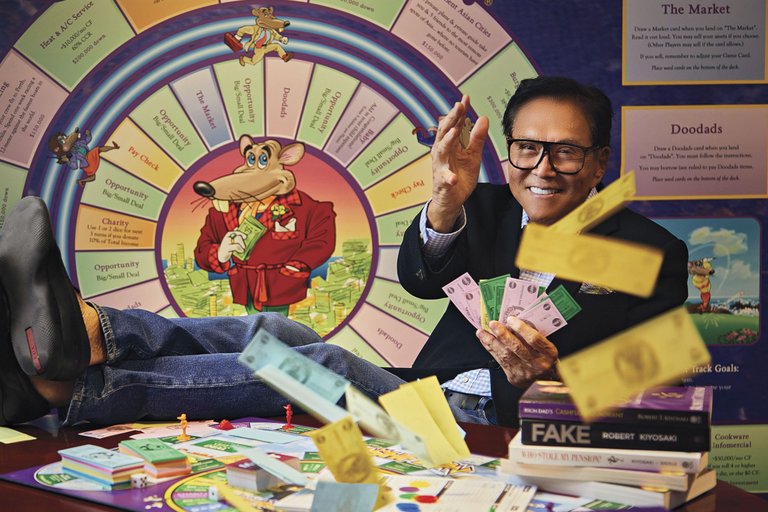Is Bitcoin Still an Alternative to Fiat Money or Merely a Speculative Asset? Robert Kiyosaki’s Perspective

Does it make sense to consider Bitcoin as an alternative to fiat currency, or has it become a purely speculative asset? According to Robert Kiyosaki, best known for his bestseller Rich Dad, Poor Dad, Bitcoin remains a key “safe haven” asset. Kiyosaki, with his non-traditional investment style and skepticism toward conventional finance, has turned to Bitcoin as a hedge against economic instability, alongside other hard assets like gold and silver. His approach reflects a belief that diversifying into decentralized assets can shield investors from the depreciating value of traditional currencies.
Kiyosaki’s View on Fiat Currency and Bitcoin’s Role as a Hedge Against Inflation
Kiyosaki has long criticized the current monetary system and policies by the U.S. Federal Reserve, arguing that the dollar is prone to depreciation under inflationary pressures. For him, Bitcoin offers a way to protect wealth from this inflationary erosion due to its decentralized nature and independence from government or central bank control. Unlike fiat currencies, Bitcoin has a fixed supply, which makes it less vulnerable to inflationary policies that can devalue traditional money over time.
Why Robert Kiyosaki is Betting Big on Bitcoin
Kiyosaki’s stance on Bitcoin aligns with his broader investment philosophy, favoring tangible and decentralized assets over traditional financial products. While he is best known for endorsing gold, silver, and Bitcoin (BTC), he has also invested in less conventional assets, like Solana (SOL), Wagyu cattle, and real estate. In an October 30 post, he provided a straightforward reason for his preference for Bitcoin, explaining that holding BTC makes him “richer” compared to holding traditional currencies, like the U.S. dollar, which he believes diminish his wealth over time.
The data supports Kiyosaki’s point: an investment of $1,000 in Bitcoin on October 31, 2019, would be worth around $7,865 today, a significant return. By comparison, the same amount held in U.S. dollars would have lost purchasing power due to inflation, with $1,000 in 2019 equivalent to only about $1,225.20 today. For Kiyosaki, Bitcoin’s appreciation serves as a hedge against fiat devaluation, validating his “simplistic but effective” approach.

The Challenges of Bitcoin’s Volatility: An Argument for Long-Term Holding
While Kiyosaki’s reasoning is simple, it may overlook Bitcoin's volatility. For example, had the same $1,000 investment in BTC been made just two years ago, returns would be positive but significantly lower. On the flip side, an investment in March 2024 would have decreased in value by October of that year, highlighting the risks associated with Bitcoin’s price fluctuations. Nonetheless, Kiyosaki argues that volatility doesn’t undermine Bitcoin’s value as a long-term hedge. He believes that, despite fluctuations, Bitcoin remains a powerful way to preserve wealth outside traditional currencies, which are at the mercy of central bank policies.
Comparatively, a $1,000 investment in the S&P 500 made in 2019 would have doubled in value, reaching about $2,000. However, this is still much lower than Bitcoin's performance over the same period. For even higher returns, an investor could have chosen Nvidia, where a $1,000 investment in 2019 would have grown to $27,000 by October 2024. While Bitcoin's performance hasn’t matched certain high-growth stocks, Kiyosaki’s emphasis is on Bitcoin’s unique qualities as a decentralized, inflation-resistant store of value.
Comparing Bitcoin with the U.S. Dollar: Is It a Fair Contrast?
Bitcoin was initially created as an alternative to fiat currency, offering people a way to avoid wealth erosion from central bank actions—a particularly compelling idea after the 2008 financial crisis. However, in 2024, Bitcoin primarily functions as a high-risk investment rather than a widely accepted medium of exchange. Although Bitcoin is accepted in many places as payment, it hasn’t yet achieved the stability required for daily transactions and often acts more as a “digital gold.”

Moreover, comparing Bitcoin to traditional currencies like the U.S. dollar has limitations. While fiat currencies are designed to be stable for daily transactions, Bitcoin’s price can experience significant fluctuations, making it less practical for purchasing goods and services. For instance, in recent years, $1,000 held in dollars from 2019 to 2022 retained more stable value despite experiencing inflation. By contrast, Bitcoin's value fluctuated greatly over the same period, hitting highs like $61,443 in October 2021 before settling at $34,668 in October 2022.
Bitcoin and Fiat Currency: Diverging Roles and Uses
Despite these differences, some argue that Bitcoin’s inherent volatility doesn’t negate its purpose as a hedge against inflation. Kiyosaki’s support for Bitcoin centers around its potential to provide security in a fiat-based economy prone to inflationary risks. Yet, its volatility makes it challenging to compare directly to fiat money like the dollar, designed to provide consistent value for regular transactions. Bitcoin’s appeal lies more in its long-term store of value than its ability to serve as an everyday currency—an idea that aligns with Kiyosaki’s emphasis on wealth preservation amid economic instability.

Kiyosaki’s faith in Bitcoin as a hedge against inflation highlights an emerging view that traditional financial systems may struggle to protect wealth amid economic uncertainties. While Bitcoin may not replace fiat currency as originally envisioned, for investors like Kiyosaki, it offers a valuable tool to preserve purchasing power and mitigate inflationary risks, affirming its role as a modern “safe haven” asset rather than a currency replacement.